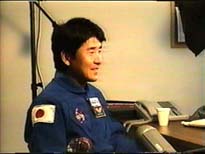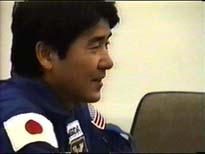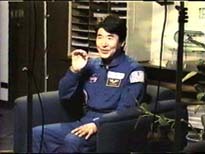|
|||||
 |
 |
| Profile
| Interview | Astronaut
Doi ready for EVA |
| Astronaut Doi's schedule
until Launch | Message to
Astronaut Doi |
| Today's activity of astronaut
Doi | Astronaut Doi's Status
Report |
| Interview to Astronaut Doi | |||||||
|
 Time:
October 6, 1997
Time:
October 6, 1997
Place: NASDA Houston Office
Q: It's now about a month away from your launch. How
is your preparation going?
A: The training is now in its peak, so we are very busy now. One session of
an EVA training is six hours long, and so far we have done nine sessions with
four more to go. It takes this much practice to master the necessary techniques
for EVA. In each training there is a new discovery, so it is very rewarding
work. EVA training requires a deal of concentration and it is really exhausting,
but I know I'm getting better each time, and teaming with Winston,
I am learning to asses the situation around me.
Q: What other training do you need to do?
A: There's a lot. EVA training is the most tough one, but the next is the
Joint Integrated Simulation (JIS). We take a time slice out of the actual
mission time line, and we rehearse the mission with all of the ground staff
at Mission Control Center. The JIS takes place once or twice a week. This
week we are doing a twelve hour rehearsal for the retrieval of SPARTAN.
Q: What is the meaning of this mission's EVA to the International
Space Station?
A: The main objective of our mission's EVA is to evaluate the performance
of an EVA crane to be used for the International Space Station. This crane
is about 1.8 meters high, and 5.3 meters long when the boom is extended. This
crane will be used during the construction of the International Space Station
to move large objects that astronauts are unable to handle.
Q: From now until launch, what is the most difficult training?
A: There are four more EVA training sessions, and a launch rehearsal called
the Final Countdown in the beginning of November. In this training, we will
don the orange flight suit and board the Orbiter standing on the launch pad
at Kennedy Space Center.
Q: How tough are these training?
A: Both physically and mentally, it's very tough. But only by completing all
of these training I will be prepared for the mission. The crew members of
STS-87 is a very good team, and we are supporting each other during these
tough times.
 Q:
You still have some training to do before launch, but at this point, how prepared
are you?
Q:
You still have some training to do before launch, but at this point, how prepared
are you?
A: I can manage to conduct my task even now, but another month of training
will give me even more confidence.
Q: The EVA done from the Russian Space Station MIR looked
very slow.
A: You need to get used to the space environment, so your movement are very
slow. A gentle push of the wall will make your body spin. We need to calculate
these effects of space environment and move carefully in the most effective
manner.
Q: What is the most difficult task during the EVA?
A: In order to move from one place to another in space, you will always have
to grasp something to prevent yourself from floating away. But if your grip
is too tight, your body will move in the other direction. You must softly
touch the handrails and move along. This is the basic point of moving in space.
Q: Do you learn to control your body movements through your
training?
A: It is impossible to make a complete simulation of the space environment
during training. Even the training conducted in the pool at NBL is different,
because the water will generate resistance and therefore body movements will
be more stable and predictable than in space. The only way to master moving
in space is to actually do this in space.
 Q:
How will it feel to step out of the airlock into space?
Q:
How will it feel to step out of the airlock into space?
A: I'm really looking forwards to the experience. I am thinking of going out
of the hatch head first. The shuttle will be facing the Earth, so this would
be the first thing that I will see.
Q: You are an amateur astronomer. What would you like to
see in space?
A: I would like to watch the Earth as long as possible. I've only seen the
north half of the Milky Way, so I would especially like to see the southern
part from space.
Q: What is your favorite constellations?
A: I like the winter Orion, the summer Harp, the Milky Way and spherical global
clusters. I will not bring a telescope with me on board, but the shuttle is
equipped with a binocular, so I will use this to observe the stars.
Q: Astronaut Wakata did Japanese calligraphy during his
mission. Do you plan to do anything special?
A: I will draw some pictures of the stars and the shuttle with color pencils
and crayons.
Q: Crayons?
A: We cannot use liquid paint in the shuttle, so I will bring a set of 24
color crayons. I am not particularly an artist, but I am fond of drawing pictures.
Q: Were there any other astronauts who drew pictures in
space?
A: Maybe. But for NASDA this is the first time. In the future, the Space Station
will probably accommodate studies in areas other than science, which will
open the doors for artistic activities in space. This will also be an experiment
to see if drawing pictures in space is possible.
 Q:
Have you decided what personal items you will bring to space?
Q:
Have you decided what personal items you will bring to space?
A: I have already handed them over to NASA. These are all precious items,
such as the lens from my first binocular, and some things from my friends.
Q: Will you use that lens in space?
A: No, I can not open these personal items in space.
Q: Are you bringing a soccer flag to space?
A: Soccer was my favorite sport since I was a child, so I will bring a flag
from the Japanese soccer league. I am not sure about my plan to bring a soccer
ball yet.
Q: What is space to you?
A: Our frontier, mankind's future place for activities.
Last Updated : November 12, 1997
| Profile
| Interview | Astronaut
Doi ready for EVA |
| Astronaut Doi's schedule
until Launch | Message to
Astronaut Doi |
| Today's activity of astronaut
Doi | Astronaut Doi's Status
Report |

|